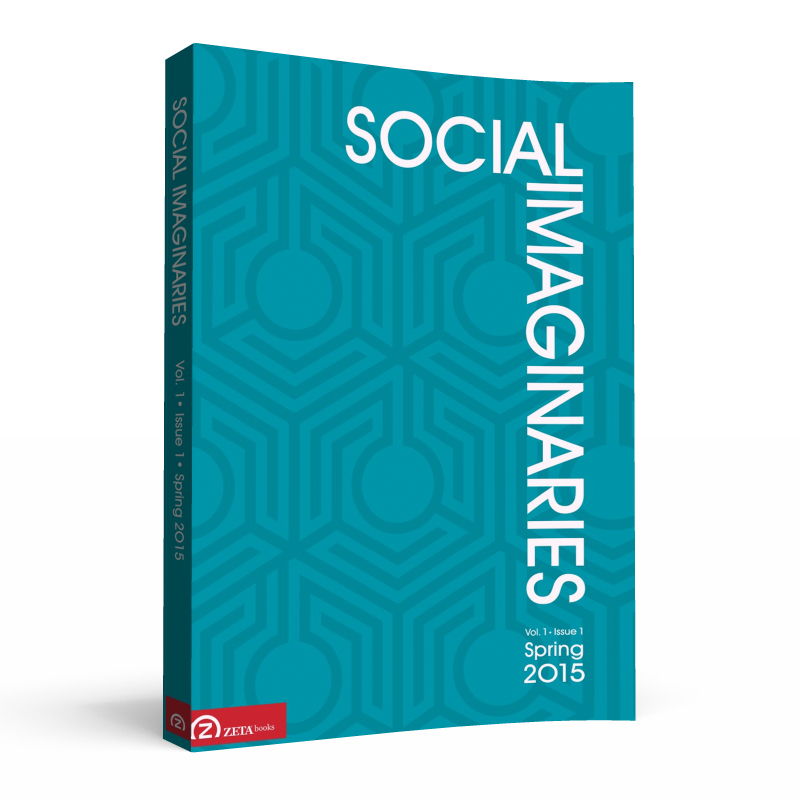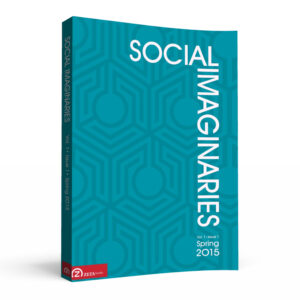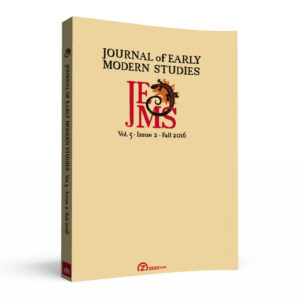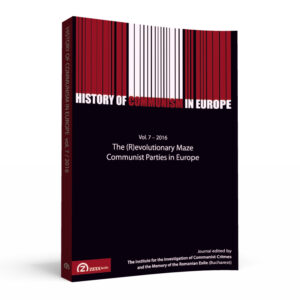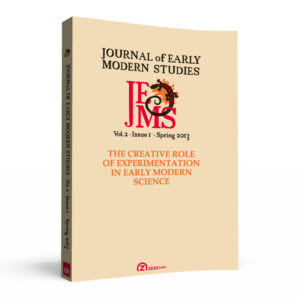Table of Contents
Editorial: Social Imaginaries Editorial Collective
Suzi Adams, Paul Blokker, Natalie J Doyle, John Krummel, and Jeremy C A Smith: Social Imaginaries in Debate
- Abstract: Investigations into social imaginaries have burgeoned in recent years. From ‘the capitalist imaginary’ to the ‘democratic imaginary’, from the ‘ecological imaginary’ to ‘the global imaginary’ – and beyond – the social imaginaries field has expanded across disciplines and beyond the academy. The recent debates on social imaginaries and potential new imaginaries reveal a recognisable field and paradigm-in-the-making. We argue that Castoriadis, Ricoeur, and Taylor have articulated the most important theoretical frameworks for understanding social imaginaries, although the field as a whole remains heterogeneous. We further argue that the notion of social imaginaries draws on the modern understanding of the imagination as authentically creative (as opposed to imitative). We contend that an elaboration of social imaginaries involves a significant, qualitative shift in the understanding of societies as collectively and politically-(auto)instituted formations that are irreducible to inter-subjectivity or systemic logics. After marking out the contours of the field and recounting a philosophical history of the imagination (including deliberations on the reproductive and creative imaginations, as well as consideration of contemporary Japanese contributions), the essay turns to debates on social imaginaries in more concrete contexts, specifically political-economic imaginaries, the ecological imaginary, multiple modernities and their inter-civilisational encounters. The social imaginaries field imparts powerful messages for the human sciences and wider publics. In particular, social imaginaries hold significant implications for ontological, phenomenological and philosophical anthropological questions; for the cultural, social, and political horizons of contemporary worlds; and for ecological and economic phenomena (including their manifest crises). The essay concludes with the argument that social imaginaries as a paradigm-in-the-making offers valuable means by which movements towards social change can be elucidated as well providing an open horizon for the critiques of existing social practices.
Johann P. Arnason: Introduction to Castoriadis’s “The Imaginary As Such”
Cornelius Castoriadis: The Imaginary As Such (translated by Johann P Arnason)
- Abstract: This text is a draft introduction to a planned work on imagination in society and history. It begins with reflections on the abilities and activities that set human subjects apart from other living beings and thus at the same time enable the ongoing creation of society and history. This is to be understood as an exploration within the ‘order of facts’, on the level of anthropological preconditions. The most elementary precondition is the human capacity to add an‘unreal extension’ to reality, and thus to put the latter at a distance; considered as an activity, this is what defi nes the imagination, but considered as a dimension of human existence, it is the realm of the imaginary. The two concepts are strictly complementary. To clarify their role in the proposed rethinking of social-historical being, we must link them to closer analysis of the latter’s two main components, representing and doing. On both sides, Castoriadis emphasises the imaginary element as a decisive point against empiricist and rationalist reductions. Representing is as irreducible to perception as it is to thinking, and taking the argument one step further, both perception and thinking can be shown to be dependent on the imaginary. Similarly, on the level of doing, human action can neither be understood as a response to given needs nor as an application of pre-given representations; its creative potential presupposes an imaginary horizon. Finally it is argued that language – closely related to both representing and doing – has an imaginary dimension, central to the emergence and the enduring innovative capacity of meaning. The basic fl aw of structural linguistics was its refusal to take the imaginary source into account.
John Krummel: Introduction to Nakamura Yūjirō and his Work
Nakamura Yujiro: “The Logic of Place” and Common Sense (translated by John Krummel)
- Abstract: The essay is a written version of a talk Nakamura Yūjirō gave at the Collège international de philosophie in Paris in 1983. In the talk Nakamura connects the issue of common sense in his own work to that of place in Nishida Kitarō and the creative imagination in Miki Kiyoshi. He presents this connection between the notions of common sense, imagination, and place as constituting one important thread in contemporary Japanese philosophy. He begins by discussing the significance of place (basho) that is being rediscovered today in response to the shortcomings of the modern Western paradigm, and discusses it in its various senses, such as ontological ground or substratum, the body, symbolic space, and linguistic or discursive topos in ancient rhetoric. He then relates this issue to the philosophy of place Nishida developed in the late 1920s, and after providing an explication of Nishida’s theory, discusses it further in light of some linguistic and psychological theories. Nakamura goes on to discuss his own interest in the notion of common sense traceable to Aristotle and its connection to the rhetorical concept of topos, and Miki’s development of the notion of the imagination in the 1930s in response to Nishida’s theory. And in doing so he ties all three—common sense, place, and imagination—together as suggestive of an alternative to the modern Cartesian standpoint of the rational subject that has constituted the traditional paradigm of the modern West.
Peter Wagner: Interpreting the Present – a Research Programme
- Abstract: Sociologists have increasingly adopted the insight that ‘modern societies’ undergo major historical transformations; they are not stable or undergoing only smooth social change once their basic institutional structure has been established. There is even some broad agreement that the late twentieth century witnessed the most recent one of those major transformations leading into the present time – variously characterized by adding adjectives such as ‘reflexive’, ‘global’ or simply ‘new’ to modernity. However, neither the dynamics of the recent social transformation nor the characteristic features of the present social constellation have been adequately grasped yet. Rather than assuming a socio-structural or politico-institutional perspective, as they dominate in sociology and political science respectively, this article concentrates on the way in which current social practices are experienced and interpreted by the human beings who enact them as parts of a common world that they inhabit together. It will be suggested that current interpretations are shaped by the experience of the dismantling of ‘organized modernity’ from the 1970s onwards and of the subsequent rise of a view of the world as shaped by parallel processes of ‘globalization’ and ‘individualization’, signalling the erasure of historical time and lived space, during the 1990s and early 2000s. In response to these experiences, we witness today a variety of interconnected attempts at re-interpretation of modernity, aiming at re-constituting spatiality and temporality. The re-constitution of meaningful time concerns most strongly questions of historical injustice, in terms of the present significance of past oppression and exclusion and in terms of the unequal effects of the instrumental transformation of the earth in the techno-industrial trajectory of modernity. The re-constitution of meaningful space focuses on the relation between the political form of a spatially circumscribed democracy and the economic practices of expansionist capitalism as well as on the spatial co-existence of a plurality of ways of world-interpretation.
Suzi Adams: Introduction to Johann P. Arnason’s “The Imaginary Dimensions of Modernity”
Johann P. Arnason: The Imaginary Dimensions of Modernity (translated by Suzi Adams)
- Abstract: This paper discusses the formation of Castoriadis’s concept of imaginary significations and relates it to his changing readings of Marx and Weber. Castoriadis’s reflections on modern capitalism took off from the Marxian understanding of its internal contradictions, but he always had reservations about the orthodox version of this idea. His writings in the late 1950s, already critical of basic assumptions in Marx’s work, located the central contradiction in the very relationship between capital and wage labour: Labour power was not simply transformed into a commodity, as Marx had argued; rather, the instituted attempt to treat it as a commodity was a contradiction in itself, between the subjectivity and the objectification of labour. Castoriadis then moved on to link this claim to Weber’s analysis of the interconnections between capitalism and bureaucracy. The main contradiction of modern capitalism, whether wholly bureaucratised as in the Soviet model or increasingly bureaucratised as in the West, now seemed to be a matter of incompatible systemic imperatives: the need to control and to mobilise the workforce. Finally, difficulties with this model – and with the revolutionary expectations based on it – led to a more decisive break with classical theories and to the formulation of a bipolar image of modernity, where the vision of an autonomous society is opposed to the logic of calculation and domination, embodied in capitalist development. On both sides there is an imaginary component, irreducible to empirical givens or systemic principles. In this regard, Castoriadis remained closer to Weber than to Marx, but he also anticipated, in a distinctive way, later emphasis on the cultural dimension of modernity, and more specifically the notion of modernity as a new civilisation.
Natalie J. Doyle: Introduction to Marcel Gauchet’s “Democracy: From One Crisis to Another”
Marcel Gauchet: Democracy: From One Crisis to Another (translated by Natalie J Doyle)
- Abstract: Democracy is in crisis. This crisis is the paradoxical outcome of its triumph over its erstwhile rivals. Having prevailed over the totalitarian projects of the first half of the 20th century it has developed in such a way that it is now undermining its original goals of individual and collective autonomy. Modern liberal democracy – the outcome of an inversion of the values of tradition, hierarchy and political incorporation – is a mixed regime. It involves three different dimensions of social existence, political, legal, historical/economic, and organises power around these. A balance was achieved after the upheaval of World War II in the form of liberal democracy, on the basis of reforms which injected democratic political power into liberalism and controlled the new economic dynamics it had unleashed. This balance has now been lost. Political autonomy, which accompanied modern historicity and its orientation towards the future, has been overshadowed by economic activity and its pursuit of innovation. As a result, the very meaning of democracy has become impoverished. The term used to refer to the goal of self-government, it is now taken to be fully synonymous with personal freedom and the cause of human rights. The legal dimension having come to prevail over the political one, democratic societies see themselves as ‘political market societies’, societies that can only conceive of their existence with reference to a functional language borrowed from economics. This depoliticisation of democracy has facilitated the rise to dominance of a new form of oligarchy.
Craig Calhoun, Dilip Gaonkar, Benjamin Lee, Charles Taylor and Michael Warner: Modern Social Imaginaries Revisited: A Conversation (edited by Dilip Gaonkar)
- Abstract: The conversation seeks to extend and complicate Charles Taylor’s (2004) account of three constitutive formations of modern social imaginaries: market, the public sphere, and the nation-state based on popular sovereignty in two critical respects. First, it seeks to show how these key imaginaries, especially the market imaginary, are not contained and sealed within autonomous spheres. They are portable and they often leak into domains beyond the ones in which they originate. Second, it seeks to identify and explore the new incipient and/or emergent imaginaries vying for recognition and demanding consideration in the constitution (as well as analysis) of contemporary social life, such as the risk-reward entrepreneurial culture.

